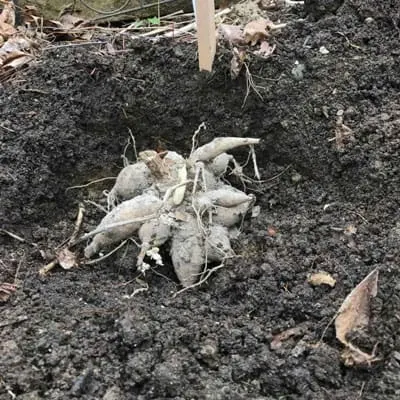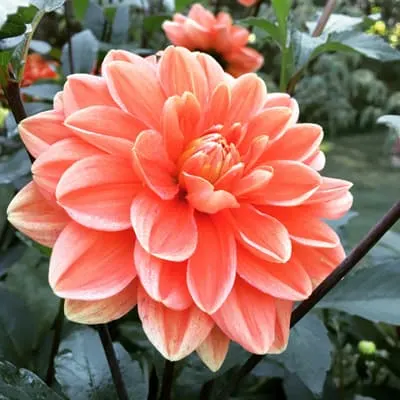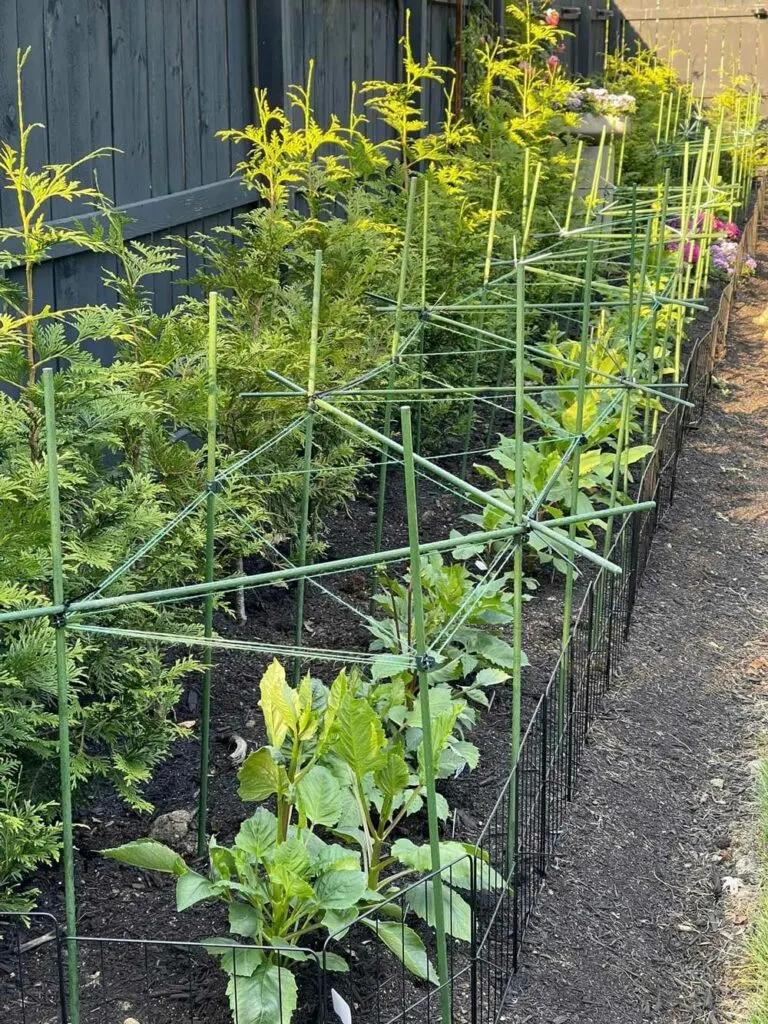Some of the links in this post may be affiliate links.
My summer garden is not complete without dahlias. A lot of dahlias. In fact, I would never have a garden without a few dahlias. Or maybe 19 dahlias…one year I planted 19 of them in my Ohio garden in late April! This blog post will help you understand every aspect of dahlia care from planting dahlia tubers, and everything that comes after that. Let’s get started!

Why do I love dahlias?
They provide a constant source of blooms all the way to the first killing frost. Yes, they may start blooming a little later than some plants, but once they start, watch out!
Sure, I grow many perennials in my Ohio garden and I love them, but I intermix many different tropical plants into my garden, and dahlias are among my favorites.
After everyone else’s gardens have fizzled out past their prime, mine is just getting started! Dahlias bloom when many other plants have pooped out.
That’s the beauty of tropicals. They keep getting better and better as the season progresses!
Their bombastic blooms offer a tropical punch to your garden and make a bold statement. And there are so many shapes, sizes and forms in the flowers. Dahlias are not for the dainty gardener.
Dahlias offer an endless supply of cut flowers. I’m constantly cutting dahlias to display indoors throughout the season.
One of my favorite things to do, although it’s somewhat depressing, is to cut an armful of dahlias right before the first killing frost.

Table of Contents
HOW TO PLANT DAHLIAS
Planting dahlias is a piece of cake. Be sure to locate your plants in plenty of sun. Dahlias come in a huge variety of heights from just a few inches tall, to towering giants that are several feet tall (and every height in between).
I like to plant the tall ones because I like to create a living wall in my garden. My intent was to create a garden “room” that you could walk into and feel like you are standing in an outdoor room, surrounded my plants.
Since I like to plant the tall varieties, the first thing I do is drive a wooden stake into the ground (I like using 6 foot stakes), and then dig a hole and drop the tuber in the hole.

The reason you want to place your stakes in the ground at the time of planting, is so you don’t accidentally drive a stake through your tubers later.
Plant your tubers about 6 inches deep or so and then cover with soil. Dahlias like a fertile, well drained soil. If you have clay, then you should amend the soil with compost or peat moss in order to make your soil more friable.
Note that the whitish residue on my tubers in the photo above are just from the perlite that they were stored in over the winter.
Normally, the rain that occurs in our Spring is enough to carry the tubers through until they start sprouting above the soil line. If your soil is very dry at the time of planting, so ahead and do an initial watering, but go light on the water until they sprout.
Your dahlias are not actively growing yet and you don’t want to cause them to rot. Once they start growing vigorously, they LOVE lots of water. Lots of sun and lots of water, but be sure your site has well drained soil.
If at any time there is a threat of frost, be sure to cover the dahlia overnight to protect it.
General Dahlia Care
1. WATERING DAHLIAS
Besides the fertilization tips I shared above, be sure to give your dahlias plenty of water. I can’t emphasize enough that your dahlias should receive plenty of of water and also be on a regular fertilization schedule. This will ensure a healthy plant with plenty of blooms.
Dahlias love very fertile and moist soil. When the surface of your garden seems dry, it is time to water. Dahlias LOVE their water but be sure that your garden site is well drained.

2. SUPPORTING DAHLIAS
If you grow the tall dahlias like I do and have to stake the plant, you’ll have to use garden twine to support the plant as it grows.
Don’t tie the plant too tightly. Just enough to support it. You can use other methods of support if you’d like, such as a tomato cage but it might be more difficult to perform any care.
3. PRUNING DAHLIAS OR TOPPING OFF
One very important tip for growing dahlias is called topping off. Topping off is where you snip off the top of the dahlia when it’s about 1 1/2 feet tall.
You’re going to be cutting off the first bloom but DON’T WORRY! This will produce a more shapely plant with more flowers. A good resource for buying dahlias online is Swan Island Dahlias.
To see how to top off a dahlias, check out this short video from Swan Island! It will be very important to do this so that you get a lot of flowers!
4. FERTILIZING DAHLIAS
Dahlias grow quickly enough even without fertilizer, but you still need to fertilize your dahlias for optimal flowering.
Choose a fertilizer that is low in Nitrogen and higher in Phosphorus and Potassium, such as a 5-10-10 fertilizer which is a typical vegetable or tomato fertilizer.

Plants don’t know the difference as far as what the label says! I’ve made the mistake in the past of using Miracle-Gro on dahlias, but this provides too much Nitrogen and results in gigantic plants with weaker stems and fewer flowers.
Don’t get me wrong, I use Miracle-Gro on plenty of my potted annuals, but it’s not suitable for everything. It may also cause tubers to shrivel in storage and not make it through the winter.
When you look at a fertilizer, you will see 3 numbers and these represent the “NPK” numbers.
If you remember the periodic table of elements in chemistry class, N stands for Nitrogen, P stands for Phosphorus and K stands for Potassium (I didn’t even have to look that up. My major in school was chemical engineering).
Nitrogen is important for foliage growth. Phosporus is important for flowering and root growth. Potassium is important for overall plant health and disease resistance.
That being said, let me tell you how I fertilize my dahlias to achieve an explosion of blooms. I like to use two fertilizers.
The first is Tomato-tone organic fertilizer (I get it from Amazon). I will mix this into the soil early in the season and then apply again per the manufacturer’s instructions.
Then about once a month, after the dahlias are up and growing, I use Morbloom 0-10-10 organic fertilizer and follow the directions as far as frequency. This is an amazing fertilizer for all flowering plants.
For more detailed information, check out my blog post on best fertilizers for dahlias.
If you give your dahlias plenty of sun water and these fertilizers, you will have an abundance of blooms! Let’s talk a little bit now about dahlia care.
5. DEADHEADING DAHLIAS
Lastly, don’t forget to regularly deadhead your dahlia. Deadheading just means to cut off the spent flowers.
You want your plant’s energy directed into continued growth and flower production, and not into going to seed!
I would be sure to deadhead your dahlias weekly for best results. Cut off the spent flowers, but also some fresh flowers to bring indoors. They make fantastic cut flowers!

STORING DAHLIAS
After you dig your dahlias up from your garden (I usually wait until the first killing frost in the Fall), this is how I prepare them to store over the winter.
In the Fall, I dig up the dahlias, shake any soil off the tubers, and then let them air dry for a day or two.
Then I store them in perlite in a box or a pot, and put them away on a shelf for the winter. It’s as simple as that.
You can overwinter them in a cool garage that stays above freezing. Or any cool, dark place will do. A cool basement is also perfect. If you can aim for storing them at around 50F (10C), this is ideal, although a little cooler would work too.
Dahlias Varieties
Here are some photographs of my garden. One of my favorite dahlias I’ve ever grown is the tall red one shown in the upper left hand corner.

This is a variety called “Groovy” and I purchased it from Swan Island Dahlias. It was a veritable flower factor all summer long. The flowers are on the smaller end, but the color is vibrant, especially set against the stunning dark foliage.
This is a very early blooming dahlias and often the first to bloom in my garden.
The beautiful dinner plate dahlia below is a variety called Spartacus. The blooms are HUGE. This plant will require plenty of support and staking so be sure to keep up with it so it doesn’t topple over.
It’s a very vigorous grower and the blooms are definitely showstoppers! Here is Sparatus, with Cornell in the background.

My “wall” of dahlias below can be see on the right hand side of the picture. This is my garden in late July one year.

Another one of my favorite dahlias is Cornell, pictured below. These are categorized as pompon dahlias.

FREQUENTLY ASKED QUESTIONS
How do you treat powdery mildew on dahlias?
Powdery mildew is one of a number of fungal diseases that can affect many garden plants, including dahlias. You can easily recognize it as a whitish powdery appearance all over the dahlia foliage.
The disease is most prevalent when it is very humid and temperatures are warm. It is also aggravated if there is poor air movement, so planting your dahlias in areas that have good air circulation is important.
If your plant isn’t too badly infected, you can treat using a sulfur-containing powdery mildew fungicide. If you have any leaves or flowers that are badly infected, prune them off.
When should you plant dahlias in the garden?
It is important to wait until the danger of frost has passed. A good rule of thumb from the American Dahlia Society is to plant dahlias at around the same time that you would plant tomatoes in your area.
If you’d like to achieve beautiful blooms earlier, you can start dahlias indoors under lights about a month or so before planting time outdoors. By giving your plants a head start, you will be able to get blooms much sooner.
You can still plant dahlia tubers as late as mid-June in most areas and still have enough time to get some blooms before the first frost if you live in colder areas.
Dahlias do not like cold soil and they respond best when the soil temperature is at least 55-60°F.
If you have planted your dahlias and they have started to grow new shoots out of the soil, but you have a risk of frost, simply place an upside-down pot over the plant to protect it until the next day.
What is the best support for dahlias?
There are numerous ways to support your tall varieties of dahlias. Unless you’re planting shorter varieties, you will need a support. You can simply use a sturdy stake that you can drive into the ground with a hammer.
Then as the dahlia grows, you can use twine to loosely tie the plant as it grows upwards.
Tomato cages are also a good option.
If you have several dahlias in a row, you can also make the support structure below. Simply drive two rows of stakes.
Then on top, you can tie more stakes diagonally for additional support, and also zig-zag some twine like you see in the photo.

As the plants grow, they will have a nice support system and you won’t see the stakes and twine as much.
How do you get a bushier dahlias plant?
First of all, make sure that you have your plant in as much direct sunlight as possible. This will help result in a bushier plant.
Then, once your plant is about 1 1/2 feet tall, cut off the growing tip of the center shoot of your plant with a pair of pruners or a sharp knife.
Even though you are sacrificing your first flower, it will result in much more vigorous, bushy plants with a lot more spectacular blooms throughout the season!
Can you grow dahlias in heavy clay soil?
Although you can grow them in clay, it’s better if you can dig in plenty of organic matter into your soil to improve the structure of the soil as well as improve drainage.
Dig in well-rotted manure and compost each year to help achieve a fertile soil with good drainage.
What zones are dahlias hardy in?
Dahlias can be left in the ground if you live in USDA zone 8 or warmer. These are tender perennials, and even if they die back to the ground, if you are in zone 8 or warmer, they will come back from the tubers.
A couple of times throughout my time growing dahlias over the years, I didn’t dig up all my tubers, and a couple planted have returned in my home which is zone 6a! Don’t count on it though.
I hope you’ve enjoyed this post and learned a few new things that you can apply in your own garden. If you’ve never grown a dahlia before, go try one out!
And if you want loads of blooms in your garden, check out my post on plants that bloom all summer long in your garden.







Rosie
Monday 3rd of April 2023
Thank you. I learned something from reading your article.
Raffaele
Monday 3rd of April 2023
You're very welcome Rosie!
Diana
Tuesday 30th of June 2020
I love dahlias and plant them every year. This year I bought them at a local greenhouse. I planted them and they look like they are dying. They’ve been planted for a little over a month. Flowers are gone off them and some leaves are turning brown. Can you tell me what I need to do. This is the first time planting them at our new home I’ve never had problems with them.
Raffaele
Tuesday 30th of June 2020
Hi Diana, it's hard to say without seeing photos and telling me how you care for them. Have you been keeping up with watering?
Hannah
Monday 22nd of July 2019
I also cannot imagine my garden without dahlias. They make my garden looks adorable and more colourful. What I love about them is the way they look and also the diversity of colours. This year I focused on growing yellow dahlias. I bought seeds of them from https://gardenseedsmarket.com/dahlia-flowered-common-zinnia-canary-bird.html and planted 2 months ago. From my experienced I also found out that watering them is very important. When I grew dahlias for the first time many of them withered because they were lack of water.
rcdilallo@gmail.com
Tuesday 23rd of July 2019
Hi Hannah. Yes, they definitely like a lot of water (and also plenty of sun and fertilizer)!
Pam levine
Sunday 23rd of April 2017
Thanks, I planted mine today. Love your blog.
rcdilallo@gmail.com
Tuesday 2nd of May 2017
Thanks Pam! Let me know if you have any questions at anytime.